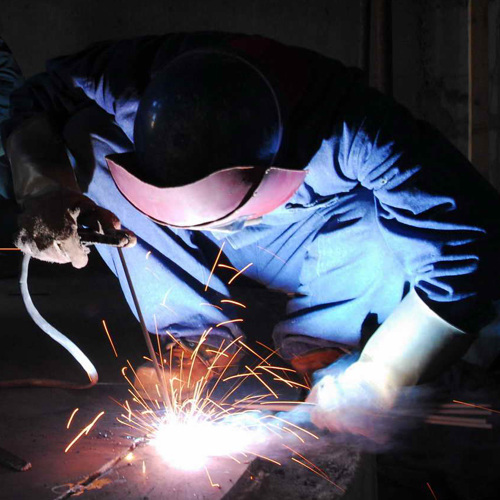Product (110)
- Promotion Products (3)
- Welding Machine (48)
- Battery Charger (4)
- Gas Cutting Machine (6)
- Welding Accessories (49)
Knowledge (3)
News (5)
Certificates (6)
Credit Report
Products Index
Company Info
Sumark Industrial Co.,Ltd. [China (Mainland)]
Business Type:Manufacturer
City: Taizhou
Province/State: Zhejiang
Country/Region: China (Mainland)
Knowledge
Arc Welding Safety

This is not a comprehensive guide. There are many ways in which welding can damage your health. The main points are:
*****Fumes
*****Slag
- Protect skin and eyes from UV light, and shield your welding area from the eyes of onlookers.
- Work in a well ventilated area (extraction fans should be used when welding inside a workshop) A vapour mask or an air fed helmet are required for special materials.
- Be careful not to leave anything flammable nearby. Welding spatter and grinding sparks can travel a long distance.
- Slag can ping off a hot weld and burn into your eyes. Use safety glasses or goggles.
*****Arc UV Light
Arc welding tends to be used for thick metal at high amps, so the light generated by the arc is very bright. Any exposed skin will become sunburned quickly so overalls and welding gauntlets (gloves) are a must.
Arc welding tends to be used for thick metal at high amps, so the light generated by the arc is very bright. Any exposed skin will become sunburned quickly so overalls and welding gauntlets (gloves) are a must.
Looking directly at a welding arc even for a short time causes arc eye where the UV from the arc burns the cornea. Expect to be awake all night with the sensation that someone is sticking pins in your eye. Also warn others in the area not to look at the arc and keep the welding area screened from public view.
Auto-darkening helmets are very useful for arc welding - with fixed shade helmets is difficult to judge where the end of the rod will first make contact with the work. A shade between around 10 and 12 would be suitable for arc.
*****Fumes
Welding fume (in total) should be controlled to ensure there is less than 5mg per cubic metre of clean air. This is surpisingly little and very easy to exceed.
Even the fumes from 6013 mild steel rods can be harmful if breathed in regularly. The best advice is to avoid as much as possible. Keep the work area well ventilated, and keep your head out of the fumes.
Being a flux shielded process it is possible to arc weld in a strong breeze, so extraction can be added close to the welding area.
For galvanised metal, stainless steel and hardfacing alloys (in fact anything other than mild steel) at least a fume mask should be used, preferably an air fed helmet, in addition to ventilation.
Some rods have fluorine coatings and these these require very careful precautions against fumes.(E 7018 contain flourine). Some cast iron rods contain Barium which should also be avoided as much as is possible. (Gasless wires can also contain Barium).
Some degreases also contain flourine


*****Spatter
There can be a lot of sparks and spatter flying around especially when learning to arc weld. Cotton overalls are more resistant to spatter than man made fabrics, and leather aprons offer excellent protection. Spatter down the neck or shoes can be especially annoying. A welding cap can help protect the head when overhead welding.
The welding area should be cleared of inflammable materials. Fires can be difficult to notice while wearing a welding helmet.
Keep a fire extinguisher nearby - Both CO2 and dry powder types are suitable. Any type that contains water (foam or water types) should not be used near mains powered electrical equipment.


*****Electric Shock
DC arc welders run at about 80V so can give an electric shock. AC welders set to 80V will have a peak current near 120V, so the risk and potential danger of a shock is higher.
DC arc welders run at about 80V so can give an electric shock. AC welders set to 80V will have a peak current near 120V, so the risk and potential danger of a shock is higher.
For a shock you would need to bridge between the electrode and the earth return. Minimise the extent of live parts by making sure all cables are in good condition (with no bare insulation or frayed wires), and that the rod holder is insulated. Welding gauntlets will help insulate only when they are dry - they can become damp with sweat.
The shock from an arc welder can be a fair jolt but is unlikely to be life threatening (unless you are also working on top of a tall building or have other health problems.)


*****Slag
Don't look closely at the weld while it cools - as the weld contracts tiny hot pieces of slag can ping off and burn themselves into your eyes. This is especially true of stainless rods.
Slag is lightweight and brittle so can fly a fair distance. Wear eye protection when chipping.


Pre Page:
TIG Welding Technique



